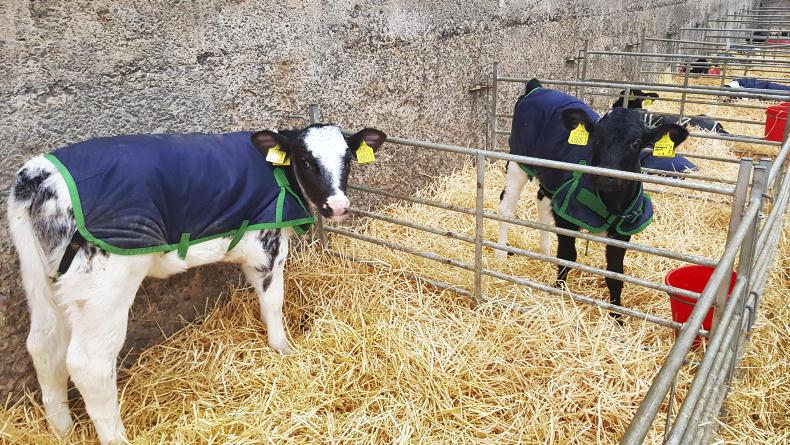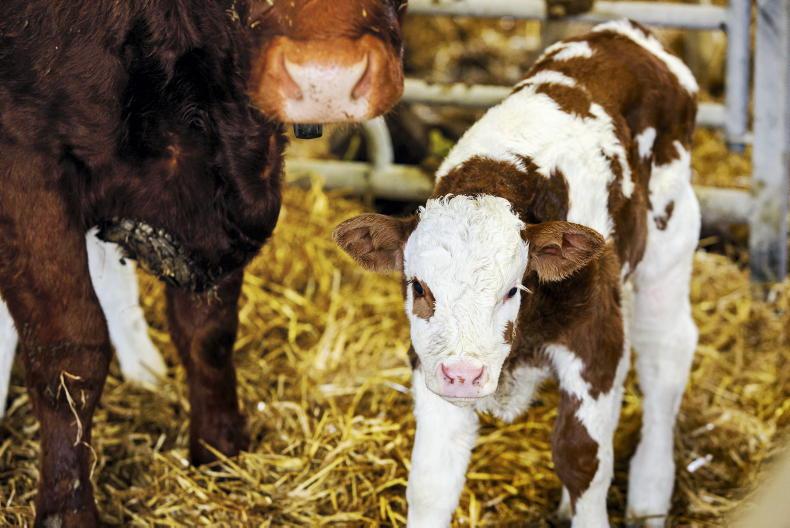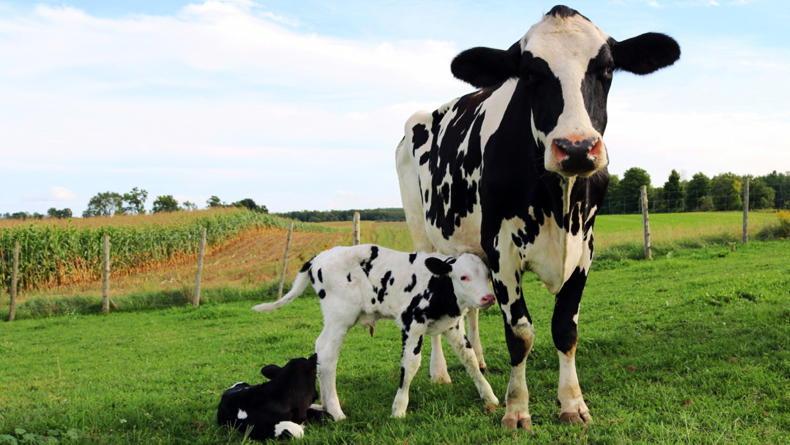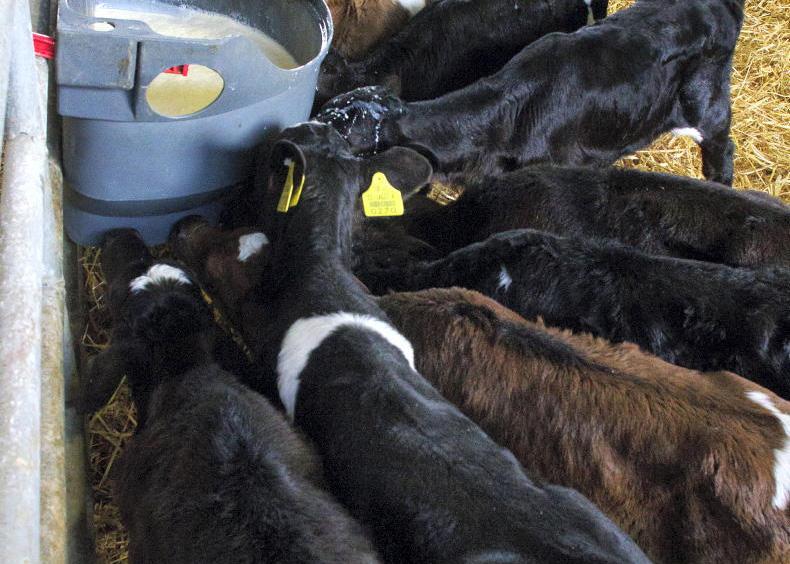Cows that are suitable to go out to grass will be selected on several programme farms over the coming weeks, ahead of the 2019 grazing season.
Most Dairylink farms have relatively high-yielding cows in autumn-calving systems, so cows that are scanned in calf and are 150 days or more in milk should be suitable candidates for early grazing.
Having good grazing infrastructure is important for getting cows out early. However, in high-yielding herds, having the right calving profile is also needed.
If cows are calving over a spread profile, then there will be fewer cows that meet the criteria to get out to grass when conditions allow.
The aim on several programme farms is to have more cows calving in the autumn, so that they produce peak yields and go back in calf when they are in the shed on silage and concentrates.
It allows more cows to produce milk from grass, the cheapest available feed, after the hard work is done in early lactation.
Calving early in the autumn also means winter bonus payments can be capitalised on.
Heifers
The focus on several Dairylink farms is to get heifers calving down at the right time and producing replacement heifer calves that will be calving at the same time two years later.
There is less emphasis put on getting older cows to calve in the autumn, as they will be culled in a few years anyway.
These cows will be bred to beef bulls or else their dairy heifer calves will be sold off, as they won’t fit in with the main group of replacements.
Phase one farmers have found that a few years of focusing on having heifers calving at the right time and getting cows back in calf over the winter allowed their calving profiles to shift towards the autumn.
Weekly round-up
Later-lactation cows settled in calf will be going to grass on Dairylink Ireland farms once conditions allow.Several programme farmers are focused on shifting their calving profile towards a tighter autumn block.Plans are being made to get slurry and fertiliser out in February on programme farms.Blood samples will be taken by vets across all livestock groups to help update herd health plans. Farmer focus: Stephen Wallace, Seaforde, Co Down
Stephen Wallace has taken a different approach to breeding on his farm near Seaforde, Co Down, this season, with a technician contracted in to take care of heat detection and AI of all maiden heifers.
The heifers are housed on an outfarm and checked by the technician once a day. Tail paint is used for heat detection and, so far, 50 out of 64 heifers have been served since breeding began on 14 December.
The new arrangement means that Stephen has more time to spend getting milking cows back in calf in the main yard.
It should also help results on the outfarm, with the technician under less time pressure checking tail paints and serving heifers than Stephen would otherwise be.
Sexed semen from sires such as Commend, Praser and Agronaut is being used on the heifers. The aim is to have heifers calve down early in the autumn (and produce a uniform group of heifer calves) to move the current spread calving profile towards a tighter autumn-calving block.
There are 123 cows milking at present, with some late-calvers still to be dried off. There are around 40 cows served so far and 70 still to calve between dry and stale cows.
From mid-March, beef bulls will be used to serve late calvers.
Early grazing
The Wallace farm is well laid out for early grazing with dry ground, a laneway network and multiple entry points to paddocks.
But to get high-yielding cows like Stephen’s to perform from grass in the spring, they need to be calving early in the autumn.
A tighter calving profile will also improve herd fertility, as cows that are slow to get in calf eventually leave the herd.
The farm was walked on Monday and covers are strong in some silage fields.

Calves will be used for a light grazing on some silage ground on the Wallace farm.
The plan is to get the oldest heifer calves out to graze down some covers ahead of slurry going on in February.
Early grazing on silage ground will help improve the digestibility of silage and is a cheaper and better-quality feed than the calves’ current diet of straw and concentrates.
Calves will be put into silage fields with good shelter and will receive some concentrates in troughs. If weather takes a turn for the worst over the next few weeks, then they will be housed again.
If calves don’t get some of the strongest covers grazed, then Stephen will consider using a trailing shoe or dribble bar for slurry.
If the covers aren’t suitable for slurry at all, then half a bag of urea will be spread in February to keep growth pushing on as temperatures rise.
Stephen’s vet will be on the farm shortly to scan heifers and cows. When he is there, blood samples will be taken from several animals in each livestock group on the farm to build a picture of what diseases the herd has been exposed to.
This information will then be used to develop a herd health plan over the coming months.
Read more
Watch: breeding progresses on Dairylink farms
Soil-sampling and recovering from TB
Cows that are suitable to go out to grass will be selected on several programme farms over the coming weeks, ahead of the 2019 grazing season.
Most Dairylink farms have relatively high-yielding cows in autumn-calving systems, so cows that are scanned in calf and are 150 days or more in milk should be suitable candidates for early grazing.
Having good grazing infrastructure is important for getting cows out early. However, in high-yielding herds, having the right calving profile is also needed.
If cows are calving over a spread profile, then there will be fewer cows that meet the criteria to get out to grass when conditions allow.
The aim on several programme farms is to have more cows calving in the autumn, so that they produce peak yields and go back in calf when they are in the shed on silage and concentrates.
It allows more cows to produce milk from grass, the cheapest available feed, after the hard work is done in early lactation.
Calving early in the autumn also means winter bonus payments can be capitalised on.
Heifers
The focus on several Dairylink farms is to get heifers calving down at the right time and producing replacement heifer calves that will be calving at the same time two years later.
There is less emphasis put on getting older cows to calve in the autumn, as they will be culled in a few years anyway.
These cows will be bred to beef bulls or else their dairy heifer calves will be sold off, as they won’t fit in with the main group of replacements.
Phase one farmers have found that a few years of focusing on having heifers calving at the right time and getting cows back in calf over the winter allowed their calving profiles to shift towards the autumn.
Weekly round-up
Later-lactation cows settled in calf will be going to grass on Dairylink Ireland farms once conditions allow.Several programme farmers are focused on shifting their calving profile towards a tighter autumn block.Plans are being made to get slurry and fertiliser out in February on programme farms.Blood samples will be taken by vets across all livestock groups to help update herd health plans. Farmer focus: Stephen Wallace, Seaforde, Co Down
Stephen Wallace has taken a different approach to breeding on his farm near Seaforde, Co Down, this season, with a technician contracted in to take care of heat detection and AI of all maiden heifers.
The heifers are housed on an outfarm and checked by the technician once a day. Tail paint is used for heat detection and, so far, 50 out of 64 heifers have been served since breeding began on 14 December.
The new arrangement means that Stephen has more time to spend getting milking cows back in calf in the main yard.
It should also help results on the outfarm, with the technician under less time pressure checking tail paints and serving heifers than Stephen would otherwise be.
Sexed semen from sires such as Commend, Praser and Agronaut is being used on the heifers. The aim is to have heifers calve down early in the autumn (and produce a uniform group of heifer calves) to move the current spread calving profile towards a tighter autumn-calving block.
There are 123 cows milking at present, with some late-calvers still to be dried off. There are around 40 cows served so far and 70 still to calve between dry and stale cows.
From mid-March, beef bulls will be used to serve late calvers.
Early grazing
The Wallace farm is well laid out for early grazing with dry ground, a laneway network and multiple entry points to paddocks.
But to get high-yielding cows like Stephen’s to perform from grass in the spring, they need to be calving early in the autumn.
A tighter calving profile will also improve herd fertility, as cows that are slow to get in calf eventually leave the herd.
The farm was walked on Monday and covers are strong in some silage fields.

Calves will be used for a light grazing on some silage ground on the Wallace farm.
The plan is to get the oldest heifer calves out to graze down some covers ahead of slurry going on in February.
Early grazing on silage ground will help improve the digestibility of silage and is a cheaper and better-quality feed than the calves’ current diet of straw and concentrates.
Calves will be put into silage fields with good shelter and will receive some concentrates in troughs. If weather takes a turn for the worst over the next few weeks, then they will be housed again.
If calves don’t get some of the strongest covers grazed, then Stephen will consider using a trailing shoe or dribble bar for slurry.
If the covers aren’t suitable for slurry at all, then half a bag of urea will be spread in February to keep growth pushing on as temperatures rise.
Stephen’s vet will be on the farm shortly to scan heifers and cows. When he is there, blood samples will be taken from several animals in each livestock group on the farm to build a picture of what diseases the herd has been exposed to.
This information will then be used to develop a herd health plan over the coming months.
Read more
Watch: breeding progresses on Dairylink farms
Soil-sampling and recovering from TB










SHARING OPTIONS